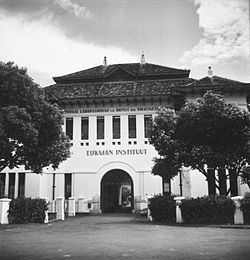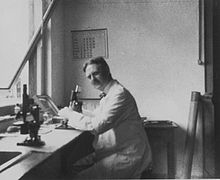Eijkman Instituut
| Eijkman Instituut (Lembaga Eijkman) | |
|---|---|
 Eijkman Instituut (built: 1914), photo from 1939 |
|
| Data | |
| place | Jakarta , Indonesia |
| Construction year | 1888 |
| Floor space | 5,500 m² |
| Coordinates | 6 ° 11 '52.8 " S , 106 ° 50' 47.1" E |
The Eijkman Instituut is an internationally recognized research institute based in Jakarta .
history
prehistory
In the course of the Dutch colonization of Java, the government sent a fleet to Aceh to curb piracy there. When the fleet came to a standstill in 1886 due to increasing beriberi diseases, the Dutch government decided to look for the cause of this "strange" disease. She set up a commission to be headed by Cornelis Pekelharing , who held a chair in pathology at the University of Utrecht .
Before Pekelharing set out on the trip to Aceh, he went to Berlin to catch up on the latest research from Robert Koch . In Koch's laboratory he met a young compatriot Christiaan Eijkman , whom Pekelharing quickly accepted into his commission and who was to accompany him to Aceh with his assistant, the neurologist Cornelis Winkler . Pekelharing and Winkler assumed an infection that could result from poor food hygiene.
In November 1886 the commission arrived in Java and carried out extensive medical examinations. When Pekelharing left again in May 1887, he suggested to the governor-general of the Dutch East Indies, Otto van Rees , that the tests be carried out by a laboratory. The governor agreed to this proposal.
First years
In 1888 a research laboratory for pathology and bacteriology was established in Weltevreden . On 15. January 1888, the military doctor was Christiaan Eijkman appointed the first director of its research on the disease beriberi the vitamin B 1 discovered. In 1929 Eijkman received the Nobel Prize in Medicine for this achievement .
Under his successor Gerrit Grijns , the laboratory became known around the world as the center for local health care and as a research facility for tropical medicine. This was also underlined by the name change to "Geneeskundig Laboratorium", which was decided by government resolution No. 17 of February 15, 1901. At Oranje Boulevard 69 (Jalan Dipenogoro 69) a new building was built in 1914, which was supposed to meet the challenges of the future.
In the chemical department of the institute, Barend Coenraad Petrus Jansen and Willem Frederik Donath succeeded in isolating the crystalline form of the B 1 vitamin in 1926.
Chaos of war
In 1938 the laboratory celebrated its 50th anniversary and has now been officially renamed the Eijkman Institute. Four years later the Second Sino-Japanese War spilled over to the Dutch East Indies , in the course of which the Dutch staff of the laboratory were immediately interned in prison camps. Since the director at the time, Willem Karel Mertens , died of Beriberi , Achmad Mochtar then became head of the institute and continued to work with the remaining Indonesian staff.
In 1944, Mochtar was accused by the Japanese occupation forces of contaminating vaccines. To avoid the torture, Mochtar, from whose institute the vaccines did not come, pleaded guilty and was beheaded on July 3, 1945.
post war period
In the post-war period, the institute gradually lost its importance as a colonial research institute. The slow decline continued until 1965 when the institute closed due to economic problems. The records from that time have been lost.
reconstruction
With the emergence of the tiger states and the economic boom in Indonesia, the need arose for a new biomedical research institute that could withstand the rapid pace of technological development. The Indonesian government promoted biotechnology and molecular biology with a national development program. In 1990 it was decided in the Indonesian Ministry of Research and Technology under Bacharuddin Jusuf Habibie to rebuild the institute. Formally, the new institute was a reopening of the Eijkman Institute and was named after him again in honor of Christiaan Eijkman's centenary. In April 1993 the institute resumed its work. On September 19, 1995, the institute was officially reopened by Indonesian President Suharto .
present
During the Asian crisis , the institute's public funding was in danger, which the institute survived through massive staff cuts.
It was only after the bomb attack on the Australian embassy in 2004 that the Eijkman Institute regained greater public attention. The scientists carried out a DNA analysis there to identify the bombers. The bomb was so massive that only small pieces of tissue from the suicide bombers could be restored and thus out of the question for conventional identification methods.
In April 2011, the Eijkman Institute entered into a cooperation with the University of Sydney with the aim of intensifying basic research in the field of molecular biology. In the course of this cooperation, the then director Sangkot Marzuki and his deputy Herath Sudoyo were awarded an honorary doctorate on April 6, 2011 .
ladder
Laboratorium voor Pathologie Anatomie en Bacteriologie
| No. | Surname | year | comment |
|---|---|---|---|
| 1 | Christiaan Eijkman | 1888-1896 | Nobel Prize Winner |
| 2 | Hermanus Frederik Roll | 1896-1899 | Provisional |
| 3 | Gerrit Grijns | 1899-1900 |
Genescult laboratory
| No. | Surname | year | comment |
|---|---|---|---|
| 4th | Johannes de Haan | 1900-1912 | |
| 5 | Gerrit Grijns | 1913-1916 | |
| 6th | Paul Christiaan Flu | 1917-1920 | |
| 7th | Henri Willem Hoesen | 1921-1923 | Provisional |
| 8th | Steffen Lambert Brug | 1924-1928 | Provisional |
| 9 | Steffen Lambert Brug | 1929-1932 | |
| 10 | Ernst Rodenwaldt | 1932-1933 | Racial hygienist |
| 11 | Pieter Jacob Teding van Berkhout | 1934-1935 | Provisional |
| 12 | Willem Karel Mertens | 1935-1942 |
Lembaga Eijkman
| No. | Surname | year | comment |
|---|---|---|---|
| 13 | Achmad Mochtar | 1942-1945 | First Indonesian Director |
| 14th | Djoehana Wiradikarta | 1945-1947 | Previously deputy director |
| 15th | Andre Gerard van Veen | 1948-1949 | |
| 16 | Raden Abdoelrachman | 1950-1965 |
Lembaga Biologiolekuler Eijkman
| No. | Surname | year | comment |
|---|---|---|---|
| Sangkot Marzuki | 1992-2014 | ||
| Amin Soebandrio | 2014- |
Research areas
- Genetics and Population Genetics
- Mitochondria
- Thalassemia and leukemia
- malaria
- Dengue fever
- hepatitis
- Influenza
- Forensic medicine
- Bioinformatics
- Emerging viruses ( host change )
credentials
- ↑ Johannes Ernst Dinger, Het aandeel van Nederland in de vooruitgang der geneeskundige wetenschap van 1900 to 1950 , in: Nederlands Tijdschrift voor Geneeskunde, No. 95 1951, page 3722
- ↑ Kenneth John Carpenter, Beriberi, White Rice, and Vitamin B: A Disease, a Cause, and a Cure , ISBN 9780520220539 , page 32f.
- ↑ Tietse Pieter Sevensma et al., Nederlandsche helden der wetenschap , NV Uitgevers-maatschappij Kosmos, Amsterdam 1946, page 305
- ↑ http://nobelprize.org/nobel_prizes/medicine/laureates/1929/eijkman.html
- ↑ Barend Coenraad Petrus Jansen, Het aandeel van Nederland in de vooruitgang der geneeskundige wetenschap van 1900 to 1950. Voeding en Vitamines , in: Nederlands Tijdschrift voor Geneeskunde, No. 96 1952, page 71
- ↑ http://www.thejakartapost.com/news/2010/02/04/sangkot-marzuki-the-brilliant-professor-behind-eijkman.html
- ↑ http://thejakartaglobe.beritasatu.com/archive/my-jakarta-the-eijkman-institute/
- ↑ Scientist Indonesia Raih Penghargaan dari Universitas Internasional ( page no longer available , search in web archives ) Info: The link was automatically marked as defective. Please check the link according to the instructions and then remove this notice.
- ↑ Annemarie de Knecht-van Eekelen, Abraham Pieter Fokker (1840-1906) en de serumtherapie bij difterie , in: Tijdschrift voor de Geschiedenis der Geneeskunde, Natuurwetenschappen, Wiskunde en Techniek 7 (1984) 161-171, page 167
- ↑ http://collecties.gemeentearchief.rotterdam.nl/Publiek/detail.aspx?xmldescid=249307 ( page no longer available , search in web archives ) Info: The link was automatically marked as defective. Please check the link according to the instructions and then remove this notice.
- ↑ http://www.deutsche-biographie.de/sfz106170.html
- ↑ PDF at www.dwc.knaw.nl
- ↑ page 73
- ↑ 69 Tahun Peringati Kematian Tragis Sang Pahlawan, Professor Achmad Mochtar, Director Pertama Lembaga Eijkman
- ↑ Visit from Faculty of Medicine, Chulalongkorn University delegation broadens collaborations


